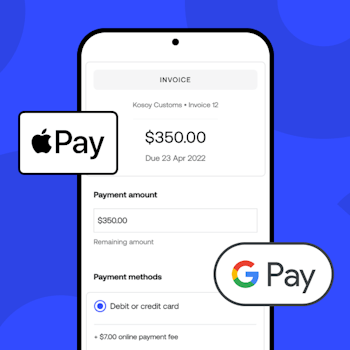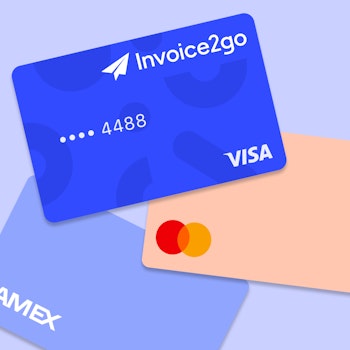Everything you need to know about small business financing
Getting a business off the ground is a huge challenge. Around 25% of all new businesses fail in the first year, and a lack of access to capital and running out of cash are two of the main reasons.
Because virtually all small businesses will need extra cash at some point, here’s a list of top small business financing strategies. Increasing your knowledge of business financing can help you avoid headaches and get the money you need to succeed. Let’s dig in!
The 6 main small business financing options
Here are the main ways businesses get funding and some tips to help you figure out which is right for you.
1. Invest time to raise funds
There’s free-ish money out there, but you have to be strategic and put in the time to get it.
Crowdfunding
Pitch your project on Kickstarter, Indiegogo, or another platform and see if the crowd will invest in your vision. Just know that crowdfunding is more than just tossing an idea against the wall and seeing who’ll throw money at it.
Crowdfunding means you need a sales pitch and a promotional video appeal for funds. With reward-based crowdfunding, you’ll need to offer perks to your backers. Between promotions, perk fulfillment, and figuring out the taxes on your proceeds (yes, it’s taxable income), you’ll need to set aside a significant amount of time for this project. Be sure to do your research before investing the time and effort.
Grants
Grants, like crowdfunding campaigns, take time, energy, and ingenuity. You’ll need to create a grant proposal and may need to supply your business plan. (Luckily, here’s a free Small Business Grant Boot Camp to help you learn the ropes!)
If you are a member of a protected class, you may find grant opportunities specific to business owners with your racial or cultural background. For example, Invoice2go, a Bill.com company, is giving away $200,000 to minority-led small businesses. All business owners can find grant opportunities locally and from companies or nonprofits.
2. The power of cash flow for small business owners
If your business isn’t super brand new, dependable cash flow is another way to finance your business.
Account receivable financing
You can use outstanding account receivables as business financing collateral. Get up to 80% of receivables advanced in less than 24 hours and the remaining funds once the invoice is paid.
To get this type of financing, you don’t need a high FICO score and only need to be in business for a year.
Merchant cash advances
An MCA technically isn’t a small business loan. Instead, it’s a cash advance based on your credit card sales. A small business can apply for an MCA and get an advance fast. So, you can entice customers with net 30 terms but not have to wait a month to get paid.
A merchant financing program is ideal for business owners who accept credit cards and want fast and easy business financing. This program is designed to help you get funding based strictly on verified cash flow.
A lender will review a few months of bank and merchant account statements. They are looking for consistent deposits, showing revenue in the tens of thousands or higher per year. They will also verify your time in business.
Lenders want you not to have a lot of non-sufficient-funds (NSFs) showing on your bank statements and not a lot of chargebacks on your merchant statements. They also want to see that you have several deposits going into your bank account in a month. Essentially, they want to see you manage your bank and merchant accounts responsibly.
MCAs vs. AR financing: What are the differences?
An MCA is funding with no debt on the balance sheet. But accounts receivable financing is cash with no debt. With MCAs, high interest and added fees are a part of the agreement. But with AR financing, there is no interest or additional fees. The amount of financing is structured around your customers’ creditworthiness.
With a merchant cash advance, the balance is repaid from a percentage of sales. A large balance remains at the end of the terms. But with AR financing, there is no repayment, as it is an instantaneous transaction with no need for terms or contracts.
MCAs are single-use and based on average monthly revenue. But AR financing has no upper limits. Businesses can choose which invoices or parts of invoices are funded, and factoring is reusable for as long as your business issues invoices.
How Invoice2go can help
What if you could be paid more quickly and bypass both AR financing and MCAs in many cases? Of course, there are times when 80% now is better than 100% in 60 days. Still, Invoice2go offers three ways to help you manage your cash flow and be paid more quickly.
- Create invoices quickly and bill clients the moment you finish a job. For businesses with a backlog, this can save a few days. It also helps because clients are billed on the heels of receiving the work, so they know what the bill is for—and what a fantastic job you just did.
- Offering multiple ways to pay means you can accept payments in person, online, via direct transfer, and more. Invoice2go can remind clients when their payments are due or overdue.
- Accept upfront deposits to get a percentage of the bill immediately.
3. Build business credit
Business credit doesn’t depend on your personal credit. And unlike personal credit, the main factor in determining business credit score from places like Equifax business, Experian business, and Dun & Bradstreet is whether your company pays its bills on time.
Business credit, in general, means business credit cards. Using business cards means you don’t destroy your utilization percentage. Plus, any inquiries from credit companies in anticipation of approving cards for you won’t affect your FICO score.
Business credit starts with credit from starter vendors, but most vendors don’t report to the business credit bureaus. Therefore, it helps to work with a company that understands business credit well and keeps up with which vendors report positive payment experiences to the credit reporting agencies.
And even starter vendors will want to see your business is set up correctly. This is a concept called fundability™. Just like you would wear a suit to a business interview, fundability means putting your business’s best foot forward when applying for credit.
Having a separate business bank account is a part of making a business more fundable. If you’re an Invoice2go subscriber, you can take advantage of a no-fee small business bank account that syncs with all your invoices and estimates.
4. Use your credit score and personal finances
Many startup business owners use their own money and credit for business financing. Bootstrapping—as it’s called—is common.
Bootstrapping with your own money
If you have significant liquid capital, putting it in your business could be your best bet. The Small Business Administration works with lenders and, often, they want to see that a business owner has “skin in the game.” But at the same time, SBA small business loans take time and effort to secure.
Traditional bank loans may also be on the table if you’ve put in a significant portion of your own funds. There are several newer online lenders in the business space. Always check on a new lender by talking to your fellow entrepreneurs and the local Chamber of Commerce. The Better Business Bureau, Yelp, and Google Reviews can also be helpful.
As with anything else, if a deal seems too good to be true, then it probably is. Also, keep in mind that the lower your credit score, the less favorable your terms will be.
Leveraging your credit
If you have a good FICO score, then you may be interested in just using your credit cards to finance your startup business. Just be careful that you don’t hurt your credit score. Maxing out your credit cards isn’t typically a good idea for funding your business. However, it is an option in emergencies.
Here’s what you need to be careful of:
Let’s say you have an excellent FICO score, and you’ve been paying your bills on time and in full for years. As a result, you have a $10,000 credit limit with Visa, a $5,000 credit limit with Home Depot, and a $3,500 credit limit with Amazon.
You’re financing your business with your personal credit cards. So, you put $8,000 on your Visa, $4,000 on your Home Depot card, and $100 charge on your Amazon card – totaling $12,100. This is just under two-thirds of your total overall available credit.
To break it down, it’s 80% of the limit on your Visa ($8,000/$10,000), also 80% on your Home Depot card ($4,000/$5,000), and about 2.8% on your Amazon card ($100/$3,500).
When it comes to your personal credit score, credit utilization counts for 30%! The credit reporting companies (Equifax, Experian, and TransUnion are the big ones) prefer if your utilization is under 30%. By charging two-thirds of your overall available credit, you’ve just significantly lowered your FICO score.
In contrast, your payment history accounts for 35% of your FICO score. Therefore, these one-time charges can negate your excellent payment history.
The other factors are: 15% for the length of credit history, 10% for new credit, and 10% for credit mix.
5. Leverage collateral to get cash
When we think of collateral, we may think of our homes. But you can get more creative!
Securities financing
If you own stocks and bonds, you can use them as loan collateral. If you’re sitting on Pfizer stock willed to you by your late Aunt Ethel, they can be a great form of collateral.
Retirement plan financing
Do you have an Individual Retirement Account (IRA) or 401(k)? The IRS allows you to use it to invest in your new business. The ROBS program (Rollover as Business Startup) lets you change the trustee for your IRA or 401(k). Your capital flows into your business as an investment. Hence, rather than a more traditional 401(k) investing in something like energy stocks, your ROBS account invests in your company.
Taking a loan from a 401(k) or IRA means paying interest. Not so with a ROBS plan.
The biggest negative happens if your business fails. According to the IRS, you can lose your hard-earned retirement funds. (Let’s just call that an incentive to succeed!)
Book of business financing
This is a rare type of financing – only for the owners of insurance agencies. You can use your client list as collateral for a business loan. And you can even use a book of business to buy the insurance agency which owns that book of business.
One downside is you can’t use this form of business financing to buy or borrow against a State Farm Insurance agency. And, of course, this is only for insurance agencies.
6. Using business equity to get cash
Most people have heard of this: taking on another founder, board member, or the like. But it can also mean what’s called angel investing.
Angel Investing
You effectively sell some of your business to a backer (an “angel”) with angel investing. Angel investing is often informal and The Securities and Exchange Commission doesn’t control it. Possibly the best-known company financed by angels is Apple. In 1977, Mike Markkula invested $250,000 – and the rest is history.
The upside is the informality. But the downside is also the informality. While written contracts and agreements are not required, they’re a good idea anyway – particularly if your parents are investing and you still want to be invited to Thanksgiving.
Angel investors tend not to want large chunks of your business, and they also tend to be passive investors. But a written agreement can help you define roles and responsibilities. If there’s a disagreement between you and your investor(s), you’ll be glad you put everything in writing.
Venture capital
Venture capital is on a far larger scale than angel investing. A venture capital firm might offer a lot of money. But they want a lot of your business in return — maybe even a controlling stake. If you give up a controlling stake and a VC thinks you’re underperforming, you could end up shut out of your own company.
But this time, the Securities and Exchange Commission is involved. With a far more formal arrangement, a VC firm will require a valuation of your business. Now everything will be in writing, so it’s time to put your lawyer on speed dial.
But let’s step back for a moment.
Venture capital firms will only want to put their money into game-changing, often disruptive industries and businesses. Think Airbnb, not your corner dry cleaner. While a venture capital firm’s money would be nice, it won’t be within reach for most small businesses.
Takeaways for small business owners
Your business may need some extra funds to take its next steps. It quite literally pays to be creative when getting small business financing, managing it, and spending it. Help is out there!
Related Articles

How to accept credit card payments on Invoice2go in 3 simple steps

Accept payments online via Apple Pay and Google Pay

Must-not-miss write-offs as you wrap up 2022 year-end finances

5 ways accepting credit and debit card payments helps your business stay resilient

4 easy ways to increase cash flow today

What is Small Business Saturday and why is it important?
The features and surprising benefits of a well-designed packing slip
